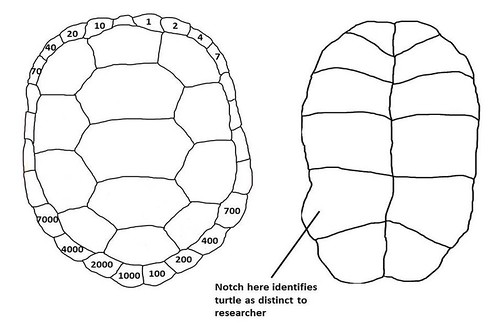About This Project
The Diamondback terrapin, a threatened species, is a key species in the salt marsh. This study will capture, mark and release terrapins to map the overall health and population surrounding Chincoteague Island in Virginia. By recording key demographic parameters among the local population this study will help determine if this Tier 2 Threatened species needs further legal protection to help regain the populations it maintained early in the 1900's.Ask the Scientists
Join The DiscussionWhat is the context of this research?
Early in the 1900’s Diamondback terrapins (Malaclemys terrapin) were trapped heavily for export to commercial restaurant chains due to the quality of their meat. After many years of sustained trapping, the population of the terrapin dropped to dangerously low levels in the Chesapeake Bay area.
The terrapin is still in the process of recovering from unrestricted trapping many years ago and is classified as a Tier 2 species, citing that the terrapin has“very high conservation need” (Virginia Department of Game and Inland Fisheries). Within the Chesapeake Bay area there have not been studies done to help assess the population's health, which is the prime goal of this study, to address this gap by targeting a local population and assess its overall range and health.
What is the significance of this project?
In this study, I will quantify several population parameters that will allow the assessment of the Diamondback terrapin population surrounding Chincoteague Island, VA. The parameters that will be monitored in this study include gender ratio, age, size, weight, location and clutch size for the females. Each indicator targets an area of the population, to asses the health and size of the local terrapin population.
The data will give a better picture of the population’s overall health and demographic, giving us insight into the overall health and risk factors associated with the Chincoteague Island population. The assessment of this population will help establish the areas and overall need for further legal protection to allow this unique animal to return to its healthy population levels.
What are the goals of the project?
The ultimate goal of this project is to determine the need for further legal protection of the Diamondback Terrapin. As such, the collection of data from this study will be used to map the local population. By collecting this data, a base health level of the population can be established to not only track the health of the population, but also to help the terrapin continue its return to sustainable population levels.
Approximate age, gender, size and weight will be used to form a picture of the population's demographics, while location and egg clutch size will be used to predict high risk areas that can be targeted to help the population continually reproduce and sustain their population. Data will also be given to the VDGIF for their own assessment of the current terrapin population.
Budget
The budget for this project is primarily targeted to obtaining a boat for the study. Other funds for this study will allow the purchase of a GPS unit to map the marsh, and fuel for the boat during the duration of the study. Housing and other needs have already been spoken for, and these last items are all that remain for this project to become a reality!
Meet the Team
Team Bio
I am an undergrad student at Kutztown University of Pennsylvania majoring in Marine Science. My overall focus lies upon ecological impacts brought on by human systems, with a focus upon conservation of threatened species. My background includes biological behavior and tracking of patterns within Marine ecosystems, as well as barrier island morphology. The study that this project highlights is a new direction undertaken and designed with a faculty member whose background lies with Herpetology, where this study has been modified from his own prior experiences and data to fit my own goals in research.John Kusnierz
Even since I was a young boy, I always found myself fascinated by how things work. I took apart every pen I could get my hands on in grade school, then moved to robots in high school, competing and placing in competitions that included autonomous robots, basketball robots (from Lego pieces) and even a small robot to help with laundry clotheslines. But throughout all my tinkering and experiences, nothing kept me occupied like searching for animals, especially in the water. That drive and passion led me to Marine Science, and while the going gets tough, I enjoy the results and practices more and more as time in the lab increases and my time in front of the TV dwindles (can't say that for the computer though.....good old Microsoft office).
It was by pure chance that I happened to find experiment.com, but I must say that it has become quite the opportunity, as I have launched my first project.
In the future I wish to attend graduate school and pursue a doctorate degree, but most of all I want to be able to help the critters of unique environments survive and thrive for future generations.
Thank you for reading a little about me, and I hope that you will help support my research, because it isn't just for me, but its for all of us to protect and help support the world around us!
~John
Additional Information
I would like to thank the Chincoteague Bay Field Station for their help and housing during research.Please visit the Chincoteague Bay Field Station website to learn more about their outreach and environmental education programs located on the Eastern Coast of Virginia.
Data that I collect from this study will be tracked and mapped across the total area of the marsh. I will be catching terrapins through active and passive methods, using nets and non-lethal traps. All of the parameters that I will be measuring will give a more complete picture of how the terrapins interact with introduced predators, like raccoon's and opossums. The data will also help predict if terrapins are shifting their habitat to areas further away from human developed areas, like the large portion of Chincoteague Island.
This image is a simulated terrapin shell and the marking system that I will be using for this project. By marking the scutes shown in this picture, I will be able to assign each terrapin a unique "TIN". For example, by marking scutes 20,10 and 7 will give a TIN of 37. The plastron (bottom) of the shell will also be marked in one location as noted to ensure I know when I catch a terrapin of my own.

A BIG THANK YOU!!
Thank you for watching and reading this far into the project, and if you have donated, a personal thank you is in order!
As a small token of thanks I wish to offer a completed copy of the publication for every $25 donation, and I will be updating lab notes periodically for all to follow my progress in the study!
They even seem to smile back sometimes!

Project Backers
- 15Backers
- 106%Funded
- $1,694Total Donations
- $112.93Average Donation
